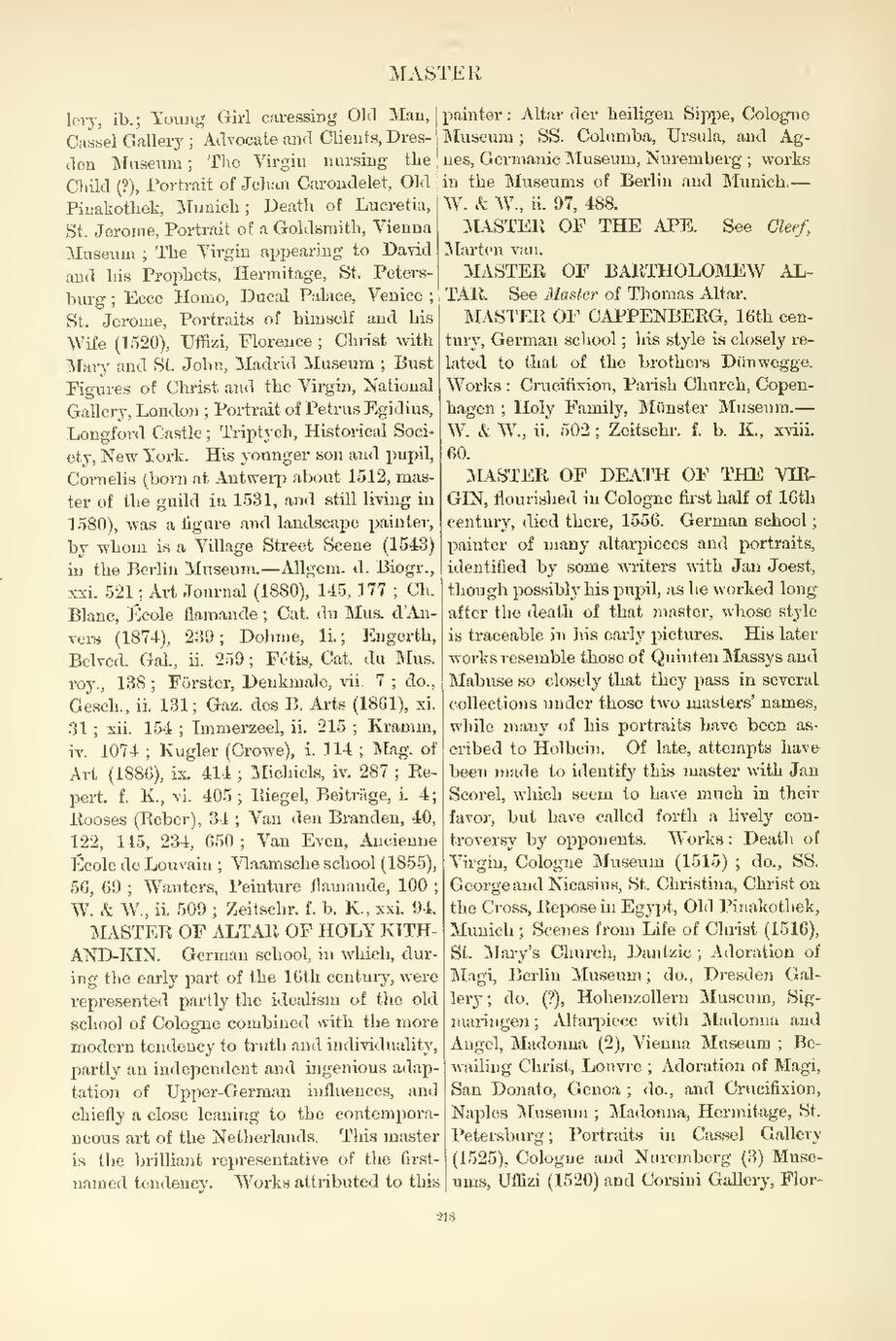- lery, ib.; Young Girl caressing Old Man,
Cassel Gallery; Advocate and Clients, Dresden Museum; The Virgin nursing the Child (?), Portrait of Jehan Carondelet, Old Pinakothek, Munich; Death of Lucretia, St. Jerome, Portrait of a Goldsmith, Vienna Museum; The Virgin appearing to David and his Prophets, Hermitage, St. Petersburg; Ecce Homo, Ducal Palace, Venice; St. Jerome, Portraits of himself and his Wife (1520), Uffizi, Florence; Christ with Mary and St. John, Madrid Museum; Bust Figures of Christ and the Virgin, National Gallery, London; Portrait of Petrus Egidius, Longford Castle; Triptych, Historical Society, New York. His younger son and pupil, Cornelis (born at Antwerp about 1512, master of the guild in 1531, and still living in 1580), was a figure and landscape painter, by whom is a Village Street Scene (1543) in the Berlin Museum.—Allgem. d. Biogr., xxi. 521; Art Journal (1880), 145, 177; Ch. Blanc, École flamande; Cat. du Mus. d'Anvers (1874), 239; Dohme, 1i.; Eugerth, Belved. Gal., ii. 259; Fétis, Cat. du Mus. roy., 138; Förster, Denkmale, vii. 7; do., Gesch., ii. 131; Gaz. des B. Arts (1861), xi. 31; xii. 154; Immerzeel, ii. 215; Kramm, iv. 1074; Kugler (Crowe), i. 114; Mag. of Art (1886), ix. 414; Michiels, iv. 287; Repert. f. K., vi. 405; Riegel, Beiträge, i. 4; Rooses (Reber), 34; Van den Branden, 40, 122, 145, 234, 650; Van Even, Ancienne École de Louvain; Vlaamsche school (1855), 56, 69; Wauters, Peinture flamande, 100; W. & W., ii. 509; Zeitschr. f. b. K., xxi. 94.
MASTER OF ALTAR OF HOLY KITH-AND-KIN.
German school, in which, during
the early part of the 16th century, were
represented partly the idealism of the old
school of Cologne combined with the more
modern tendency to truth and individuality,
partly an independent and ingenious adaptation
of Upper-German influences, and
chiefly a close leaning to the contemporaneous
art of the Netherlands. This master
is the brilliant representative of the first-*named
tendency. Works attributed to this
painter: Altar der heiligen Sippe, Cologne
Museum; SS. Columba, Ursula, and Agnes,
Germanic Museum, Nuremberg; works
in the Museums of Berlin and Munich.—W.
& W., ii. 97, 488.
MASTER OF THE APE. See Cleef,
Marten van.
MASTER OF BARTHOLOMEW ALTAR.
See Master of Thomas Altar.
MASTER OF CAPPENBERG, 16th century,
German school; his style is closely related
to that of the brothers Dünwegge.
Works: Crucifixion, Parish Church, Copenhagen;
Holy Family, Münster Museum.—W.
& W., ii. 502; Zeitschr. f. b. K., xviii.
60.
MASTER OF DEATH OF THE VIRGIN,
flourished in Cologne first half of 16th
century, died there, 1556. German school;
painter of many altarpieces and portraits,
identified by some writers with Jan Joest,
though possibly his pupil, as he worked long
after the death of that master, whose style
is traceable in his early pictures. His later
works resemble those of Quinten Massys and
Mabuse so closely that they pass in several
collections under those two masters' names,
while many of his portraits have been ascribed
to Holbein. Of late, attempts have
been made to identify this master with Jan
Scorel, which seem to have much in their
favor, but have called forth a lively controversy
by opponents. Works: Death of
Virgin, Cologne Museum (1515); do., SS.
George and Nicasius, St. Christina, Christ on
the Cross, Repose in Egypt, Old Pinakothek,
Munich; Scenes from Life of Christ (1516),
St. Mary's Church, Dantzic; Adoration of
Magi, Berlin Museum; do., Dresden Gallery;
do. (?), Hohenzollern Museum, Sigmaringen;
Altarpiece with Madonna and
Angel, Madonna (2), Vienna Museum; Bewailing
Christ, Louvre; Adoration of Magi,
San Donato, Genoa; do., and Crucifixion,
Naples Museum; Madonna, Hermitage, St.
Petersburg; Portraits in Cassel Gallery
(1525), Cologne and Nuremberg (3) Museums,
Uffizi (1520) and Corsini Gallery, Flor-
